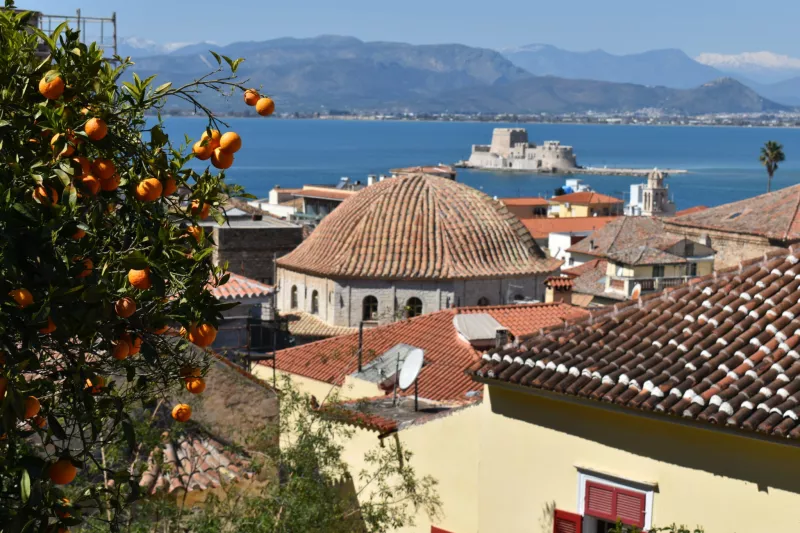By Nicolas Bard
The Nafpliowhich was the capital of the Greek state from 1827 to 1834, is one of the most beautiful and historic cities in our country, and one of the most important ports of the eastern Peloponnese. The city is built on the southeast end of the fertile Argolic plain, on the coast of the Argolic Gulf and is known for its iconic architecture, historical monuments, the excellent preserved old town that is a pole of attraction for thousands of visitors, and of course. The whole historic center of the city has
It is described as preserved, revealing the glamor that the area once met. The imposing Palamidi that stands as a crown at the top of the hill, the coastal magnificent route of Akronafplia, the iconic Bourtzi and the picturesque paved bougainvilleas create a rare and beautiful urban mosaic that we find.
Let’s look at then three of Nafplio’s most important monuments and sights, worth a visit if you are in the area!
Bourtzi
Bourtzi, the emblem and trademark of Nafplio, is a monument of great importance and one of the most important fortifications in Greece. It was built during the First Venetian occupation, when he was predictive (commander) of Nafplio, Vittore Pasqualigo, who initially gave him his name (Castel Pasqualigo).
During the Venetian occupation it was known as the “fortress of the rock” or “of the sea” (Castello dello Scoglio or Castello A Mare). Later, during the Revolution, the names “Seafood” and “Kasteli” were used. The name “Bourtzi”, with which it is known to date, was established during the Turkish occupation. The purpose of its construction was to protect the entrance to the port of the city. The main objective of the fort was to prevent – in collaboration with the “five brothers” bastion – the entrance to the port, since it is only on this side that it is possible to
crossing large ships, as on the north side the small depth of the water prevents
navigation.
The fortress has served the city’s defense for about 350 years, and received several repairs and modifications. During the Greek Revolution, it played an important role in the liberation of Nafplio, but suffered serious damage mainly to its south side, from which it was also a fire. Then, after 1833, it was used as a place of residence of the Demean, leaving the island only for the executions of guillotine taking place in Palamidi. When the executions stopped, the fortress was abandoned.
Palamidi
Palamidi is one of the most beautiful castles in Greece and the largest and best preserved fortress complex of the Venetian occupation! Its construction was completed in 1714 in a record time of just a few years to serve the Venetian military and naval operations of that time. The castle follows the natural ridge of the hill and becomes one with the landscape around it. Even today it is maintained in excellent condition and is one of the most important achievements of the Venetian fortification architecture, while the view from above to the city and the Argolic Gulf is breathtaking.
The castle was designed by Giaxich, while the construction was undertaken by the French Lasalle. The plan of the fortress is based on a system of mutually integrated bastions (Dapi), which develop gradually on the West-East Axis and connected to each other with walls. The eight total bastions of the castle are independent, so that if one of them is occupied, the defense is continued by the others.
Furthermore, an uphill rise rise with small warriors leads to the Palamidi Fortress starting east of the Bastion Grimani and ending at the gate of St. Andrew’s Bastion on the NW side of the fortress. According to folk tradition, it was a staircase with 1000 steps left 999 because the millimeter was broken by Kolokotroni’s horse. The visitor can admire today, among other things, the imposing bastions, the historic church of St. Andrew and the impressive tanks that still collect the rain water of the hill.
Parliamentary
Built in the southwest of Syntagma Square, the parliament magnetizes the look from afar. This is the first House of Greeks! Initially, of course, and in particular in 1730, the building was built and served as a mosque, consisting of a large hall and a massive dome. In fact, in its west there was a domed arcade, but in the early 20th century it was destroyed by a powerful earthquake. From the autumn of 1825 until the spring of 1826, in the mosque, which had been shaped by the architect Valliano, the Greek Parliament was housed. Hence the name of a parliamentary, which the mosque is known to this day.
The site then operated by serving various purposes … It housed the Greek school, its ground floor was a prison, later in the dance versees of the Municipality, and there was also the historical trial of the Greek Revolutionary Chieftains and Th. Nowadays, the parliamentary mandate by the Ministry of Culture serves as a conference space, while on its ground floor is the municipal gallery, with works of contemporary Greek artists.
Source :Skai
I am Frederick Tuttle, who works in 247 News Agency as an author and mostly cover entertainment news. I have worked in this industry for 10 years and have gained a lot of experience. I am a very hard worker and always strive to get the best out of my work. I am also very passionate about my work and always try to keep up with the latest news and trends.












